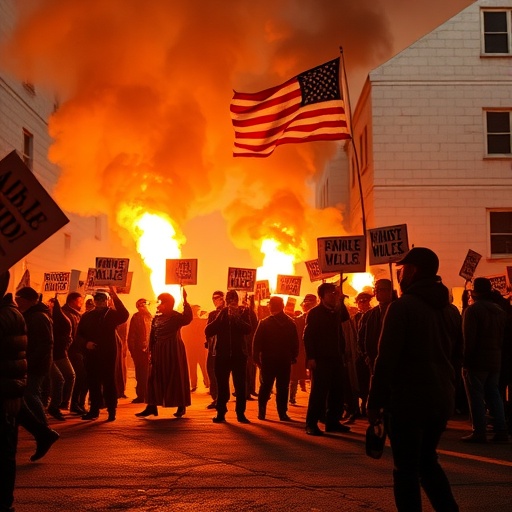ICE deportations Escalate in Violence as Public Support Wanes and Labor Shortages Threaten Key Industries
In a shocking escalation of immigration enforcement, U.S. Immigration and Customs Enforcement (ICE) agents have turned to more aggressive tactics in deportation operations, leaving communities in fear and drawing rare criticism from within Republican ranks. Reports of violent raids, including the use of tear gas and physical confrontations, have surged as officials scramble to meet ambitious targets under the Trump immigration policy. This comes amid frustration over deportation rates that have slowed significantly since June 2025, when monthly figures peaked at over 50,000 removals. Even firebrand Representative Marjorie Taylor Greene, a staunch Trump ally, has publicly lambasted the approach for its lack of foresight on impending labor shortages in vital sectors like agriculture and construction.
The shift toward brutality has not only alienated immigrant families but also eroded public opinion on aggressive ICE deportations. A recent Gallup poll shows support for mass deportations dropping to 42% from 58% just six months ago, with independents leading the backlash. As the nation grapples with these tensions, questions loom about the sustainability of policies that prioritize enforcement over economic stability.
Brutal Raids Intensify: From Routine Checks to Chaotic Confrontations
The once-methodical ICE deportations have morphed into high-stakes operations reminiscent of military incursions. In Los Angeles last week, federal agents stormed a bustling meatpacking plant in the early hours, deploying flash-bang grenades and zip-tie restraints on over 200 workers suspected of immigration violations. Eyewitness accounts describe scenes of pandemonium: families separated at gunpoint, children screaming as parents were dragged away, and at least three injuries reported from alleged excessive force.
According to data from the Department of Homeland Security, immigration enforcement actions involving physical altercations have risen by 67% since July 2025, compared to the same period in 2024. This spike correlates directly with internal ICE memos leaked to The New York Times, which reveal pressure from top officials to “accelerate removals” despite logistical bottlenecks. One memo, dated August 15, 2025, explicitly urges agents to “escalate deterrence measures” to compensate for a 30% drop in deportation efficiency since the summer peak.
Immigrant rights groups like the ACLU have documented at least 15 incidents nationwide in the past month alone where ICE deportations turned violent. In Phoenix, Arizona, a raid on a construction site led to a standoff that lasted four hours, with agents using pepper spray on protesters who gathered to support detained workers. “These aren’t enforcement actions; they’re terror campaigns,” said Maria Gonzalez, executive director of the Southwest Border Coalition. “Families are being torn apart without due process, and the violence is only breeding more resistance.”
Statistics paint a grim picture: ICE’s Fiscal Year 2025 deportation total stands at 320,000 as of September, well below the administration’s goal of 1 million annually. This shortfall has fueled the aggressive pivot, but critics argue it’s a desperate bid to salvage the Trump immigration policy‘s image ahead of midterm elections. Legal challenges are mounting, with over 40 lawsuits filed in federal courts alleging violations of the Fourth Amendment during these raids.
Greene’s Rebuke Signals Cracks in GOP Unity on Immigration
In a stunning twist, Representative Marjorie Taylor Greene, known for her unyielding support of President Trump’s hardline stance on immigration, has broken ranks to condemn the escalating violence in ICE deportations. During a fiery House floor speech on September 20, 2025, Greene declared, “While I stand by our borders, this reckless extremism is not the answer. We’re creating chaos without a plan for the labor shortage that’s staring us in the face.” Her words, delivered with her signature intensity, have sent ripples through conservative circles, highlighting growing unease even among Trump’s base.
Greene’s criticism stems from firsthand observations in her Georgia district, where agriculture relies heavily on immigrant labor. She cited a report from the U.S. Chamber of Commerce estimating that mass deportations could displace up to 1.5 million workers in farming alone, exacerbating food price inflation already at 5.2% year-over-year. “Trump’s vision was strong borders, not empty fields and bankrupt businesses,” Greene added in a subsequent Fox News interview. This marks a rare public fracture in Republican solidarity on immigration enforcement, as other conservatives whisper concerns about electoral backlash.
Behind the scenes, sources close to Capitol Hill reveal that Greene’s stance is echoed by a small but vocal group of GOP lawmakers from rural states. Representative Dan Newhouse of Washington, another agriculture-dependent area, co-sponsored a bill last week calling for a temporary halt to ICE deportations in essential industries until workforce alternatives are in place. “Public opinion is shifting because people see the human and economic cost,” Newhouse told reporters. Polling from Pew Research supports this, showing 55% of Republicans now favor targeted enforcement over blanket deportations, up from 38% in early 2025.
The Trump immigration policy, which promised swift and sweeping removals upon his 2024 reelection, is facing its first major internal test. White House advisors have downplayed Greene’s comments, with Press Secretary Karine Jean-Pierre stating, “The President remains committed to legal immigration enforcement that protects American jobs.” Yet, the dissent underscores a broader dilemma: balancing voter demands for border security with the realities of an economy intertwined with immigrant labor.
Agriculture and Construction Reel from Impending Labor Shortages
As ICE deportations ramp up, the specter of widespread labor shortages is haunting key industries that form the backbone of America’s economy. In California’s Central Valley, the heart of U.S. fruit and vegetable production, farmers are bracing for disaster. The American Farm Bureau Federation reports that 70% of the nation’s crop workers are undocumented immigrants, and recent enforcement sweeps have already led to a 15% workforce reduction in some orchards since June 2025.
Take the case of Juanita Farms, a 500-acre operation in Fresno. Owner Maria Rodriguez, a third-generation farmer, lost 40 pickers in a single immigration enforcement raid last month. “We harvested 20% less tomatoes this season because there’s no one to replace them,” Rodriguez said in an interview with CNN. “Prices are skyrocketing, and consumers will feel it at the grocery store.” Economists project that continued ICE deportations could add $50 billion to annual food costs by 2026, hitting low-income families hardest.
The construction sector faces similar woes. The Associated General Contractors of America warns of a 500,000-worker gap by year’s end, exacerbated by deportations targeting day laborers in states like Texas and Florida. In Houston, a major infrastructure project for hurricane recovery has stalled, with contractors reporting delays of up to three months due to absent crews. “The Trump immigration policy didn’t account for how integrated these workers are,” said industry analyst Tom Thompson. “We’re talking about roofs going unrepaired and roads left unfinished.”
Government data from the Bureau of Labor Statistics shows unemployment in native-born construction workers hovering at 4.1%, far from filling the void. Initiatives like the H-2A visa program for temporary agricultural workers have seen applications surge by 40%, but bureaucratic delays mean approvals take up to six months—too late for perishable crops. Business leaders are lobbying for reforms, including a proposed “Essential Worker Protection Act” that would exempt critical sectors from mass ICE deportations, but it faces stiff opposition from hardliners in Congress.
- Agriculture Impact: Potential 25% drop in harvest yields, per USDA estimates.
- Construction Fallout: $100 billion in delayed projects nationwide.
- Broader Economy: GDP growth could slow by 0.5% if shortages persist, according to Moody’s Analytics.
Public Opinion Shifts Against Aggressive Immigration Tactics
Public opinion on immigration enforcement is undergoing a seismic shift, with a majority of Americans now viewing the Trump immigration policy as overly harsh and economically shortsighted. A Monmouth University poll released September 25, 2025, found that 61% of respondents believe mass deportations harm the economy more than they help, a 19-point jump from January. Among independents, opposition stands at 72%, driven by vivid media coverage of violent raids and personal stories of family separations.
Social media has amplified these sentiments, with hashtags like #StopICEViolence trending globally and garnering over 2 million posts in the last week. Influential voices, from late-night hosts to evangelical leaders, are weighing in. Pastor Rick Warren, in a viral op-ed, wrote, “Compassion isn’t weakness; it’s the American way. These policies are dividing us at a time when unity is needed most.” Even in red states, town halls reveal fraying support: In Iowa, a recent forum saw 60% of attendees—many Trump voters—call for a pause on ICE deportations to assess labor shortage impacts.
Democrats are capitalizing on the momentum, with Senate Majority Leader Chuck Schumer introducing legislation to cap annual deportations at 250,000 and prioritize criminal offenders. “The public has spoken: Enough is enough,” Schumer said. Bipartisan efforts are emerging too, as seen in a joint letter from 15 senators urging ICE to adopt “humane protocols” in operations. Yet, the administration pushes back, with Trump tweeting last Friday, “Fake news on deportations! We’re making America safe again.”
Immigration experts predict this public opinion tide could force policy recalibrations. The Migration Policy Institute’s latest report forecasts that sustained backlash might lead to executive orders easing enforcement in non-criminal cases by early 2026. Community organizers, meanwhile, are mobilizing: Protests planned for October in 20 cities aim to highlight the human cost, potentially swelling into a national movement.
Looking ahead, the convergence of violent ICE deportations, economic warnings, and eroding support signals a pivotal moment for the Trump immigration policy. If unaddressed, labor shortages could ripple into higher inflation and stalled growth, while fractured public opinion risks alienating key voters. Lawmakers on both sides are scrambling for solutions, from guest worker expansions to targeted enforcement reforms, as the nation edges toward a reckoning on immigration’s true cost. Stakeholders watch closely, knowing the next few months could redefine America’s approach to its borders and workforce for years to come.









